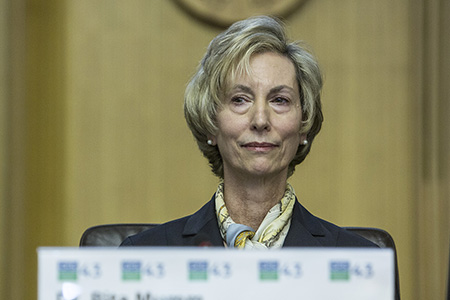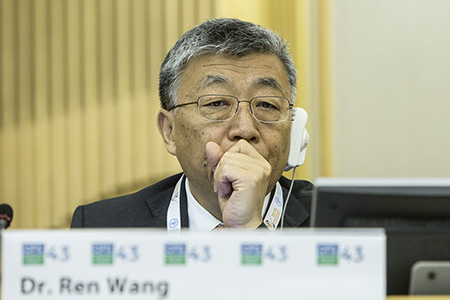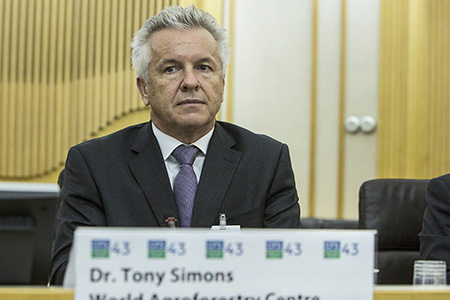Summary
The following side events were covered by ENBOTS on Monday, 17 October 2016:
- Adopting African Orphan Crops to Enhance Food Security, Nutrition and Safety
- Rome-based Agencies’ Special Event “Inclusive Value Chains for Sustainable Agriculture and Scaled Up Food Security and Nutrition Outcomes”
IISD Reporting Services, through its ENB+ Meeting Coverage, has provided web coverage of CFS 43 and selected side-events. The summary report of CFS 43 is available in HTML and PDF.
Adopting African Orphan Crops to Enhance Food Security, Nutrition and Safety
Organized by the New Partnership for Africa’s Development (NEPAD), World Agroforestry Centre (ICRAF), BGI (formerly Beijing Genomics Institute), World Wildlife Federation, Kenya, Nigeria, Ethiopia, Liberia, FAO, Mars Inc.
This side event, moderated by Yaya Olaniran, Permanent Representative of Nigeria to FAO, highlighted progress made to deploy plant genetics to end stunting, hunger and chronic malnutrition through sustainable methods in Africa, particularly the achievements of the African Orphan Crops Consortium (AOCC) and the African Plant Breeders Academy.
Amira Gornass, CFS 43 Chair, said the AOCC is a multi-sector collaboration effort, which includes government organizations, scientific bodies, the private sector, NGOs and others, adding that it offers viable solutions to hunger and malnutrition, and is important to improve consumers’ diets in Africa and elsewhere.
Ibrahim Assane Mayaki, CEO of NEPAD, reported on the AOCC, which is working to empower African plant breeders and farmers to improve the nutritional value, productivity and climatic adaptability of some of the continent’s most import food crops, including finger millet and spider plant. The consortium, he said, aims to train top plant breeders from Africa, who will enhance the capacity of local institutions, increase farmer knowledge and management, and promote conservation of African crops.
Howard-Yana Shapiro, Mars Incorporated, presented on nutritional insecurity, noting that 37% of children in Africa are stunted physically, neurologically and economically as a result of malnutrition. To combat this, he said the AOCC is using state-of-the-art genomics to sequence 101 key African food crops in an effort to enhance their nutritional value and increase yields, adding that since July 2016, 26 plants have already been sequenced by African scientists.
Rita Mumm, African Plant Breeding Academy, presented on the education programme, which trains African plant breeders in advanced technologies and methods, specifically how to breed indigenous plants in Africa to be more nutritious and productive. She noted that 52 scientists (20% of them women) from 20 countries across Africa have been trained. The goal, she said, is to equip more scientists in methods to improve crop varieties in Africa and to pass this knowledge on to the next generation.
Tony Simons, ICRAF, spoke on how to mobilize science, stressing the need to combine science of discovery with science of delivery. He said that integrated agriculture and nutrition messaging is under-reported and under-communicated, but that initiatives like the AOCC and African Plant Breeding Academy are important to support policy. To reduce childhood stunting due to malnutrition, he said, the diversification and cultivation of African crops should be seen as an opportunity.
Ren Wang, Assistant Director-General, FAO, expressed commitment to support FAO member countries to achieve the Sustainable Development Goals, particularly by linking sustainable food systems with nutrition. He said FAO can encourage partners and governments to support the AOCC through the International Treaty on Plant Genetic Resources for Food and Agriculture (ITPGR).
In discussions, participants considered, inter alia; the weak link betweenresearch findings and end users, and with private-sector mechanisms; the need for strong leadership in science delivery at the highest level; and the need for better understanding the needs of consumers and farmers.
Rita Mumm, African Plant Breeding Academy
Copyright ©FAO. ©FAO/Alessandra Benedetti
Ren Wang, Assistant Director-General, FAO
Copyright ©FAO. ©FAO/Alessandra Benedetti
Tony Simons, World Agroforestry Centre
Copyright ©FAO. ©FAO/Alessandra Benedetti
Amira Gornass, CFS Chair
Copyright ©FAO. ©FAO/Alessandra Benedetti
Rome-based Agencies’ Special Event “Inclusive Value Chains for Sustainable Agriculture and Scaled Up Food Security and Nutrition Outcomes”
This special event, moderated by Gerda Verburg, Coordinator, Scaling Up Nutrition (SUN) Movement, introduced the role of and opportunities associated with nutrition-sensitive value chains.
David Ryckembusch, World Food Programme (WFP), noted that the value-chain approach has traditionally focused on economic value but not necessary nutritional value. He said that applying a nutrition lens to value chains can help navigate food systems, and that it is important to promote activities to increase supply and demand of nutritious food. He suggested that such activities can focus on alleviating constraints at entry points of the value chain.
Isabel de la Peña, International Fund for Agricultural Development (IFAD), outlined three impact pathways to improve nutrition strategies: production, income and market. She said the first two pathways are more geared to producers, whereas the market pathway helps consumers benefit from a food system that is nutritious as a whole. She added that nutrition awareness and women’s empowerment are important mediators of impact.
Florence Tartanac, FAO, highlighted the importance of practical tools to identify entry points along the value chains. This, she said, requires going beyond traditional value chain approaches (commodity and market focused) and broadening the concept of value from a purely economic focus to one that encompasses gender, nutrition, health and environmental dimensions.
Franklin Charpantier, Sectoral Planning on Agriculture and Livestock, Costa Rica, presented two examples of how his government is addressing food security. At the local level, he cited a project that integrates rural development and family farming and focuses on increasing awareness of food production and nutrition for children. He then cited a national plan involving 47 institutions to address food security and nutrition. Charpantier stressed the reintroduction of indigenous crops, which have huge nutritional value, and their integration into the market.
Mamadou Goita, Institute for Research and the Promotion of Alternatives in Development (IRPAD/Afrique), Mali, said that the issue of aligning economic and nutritional values of products has not yet been resolved. He stressed the need to link local producers to markets, and the importance of jobs created in markets where products are circulated; and the need to organize market systems that link circulation and profitability.
Poorva Pandya, Agri Business Development, Export Trading Group, said it is possible to introduce new crops that are both economically viable, and nutritionally valuable. She cited an example in Africa where Indian pulses were introduced due to ideal climate conditions and farmers were taught to incorporate nutritious legumes in their diets. But, she warned that it takes time for cultures to adapt to different tastes.
Laila Mokadem, African Development Bank, said the bank is prioritizing investments in food security and nutrition, such as the Feed Africa initiative. Investing along the value chain is critical, she stressed, adding that donor coordination and joining efforts with development partners are crucial to address nutrition and to achieve the SDGs.
In the ensuing discussion, participants addressed, inter alia: balancing basic needs with economic needs; promoting women’s empowerment and fair wages along the value chain; raising awareness and education; and incorporating climate change issues into the equation.
Contacts:
- CFS Secretariat - cfs@fao.org
More Information:



